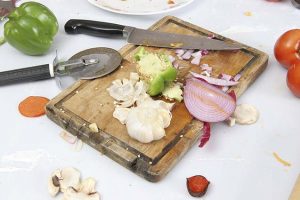Cross-contamination of raw food to other surfaces, hands, and foods is a serious issue in foodservice. With individuals eating more meals away from home, contracting a foodborne illness from a food service establishment is an increasing concern. However, most studies have concentrated on hands or food contact surfaces and neglected atypical and unusual surfaces (surfaces that are not typically identified as a source of cross-contamination) and venues. This review seeks to identify atypically cross-contaminated surfaces and atypical venues where cross-contamination could occur that have not been examined thoroughly in the literature.
 Most surfaces that could be at risk for cross-contamination are frequently touched, rarely cleaned and sanitized, and can support the persistence and/or growth of foodborne pathogens. These surfaces include, menus, spice and condiment containers, aprons and coveralls, mobile devices and tablets, and currency, among others. Venues that are explored, temporary events, mobile vendors, and markets, are usually limited in space or infrastructure, have low compliance to proper handwashing, and provide the opportunity for raw and RTE foods to come into contact with one another. These factors all create an environment where cross-contamination can occur and potentially impact food safety. A more comprehensive cleaning sanitizing regime encompassing these surfaces and venues could potentially help mitigate the cross-contamination described here.
Most surfaces that could be at risk for cross-contamination are frequently touched, rarely cleaned and sanitized, and can support the persistence and/or growth of foodborne pathogens. These surfaces include, menus, spice and condiment containers, aprons and coveralls, mobile devices and tablets, and currency, among others. Venues that are explored, temporary events, mobile vendors, and markets, are usually limited in space or infrastructure, have low compliance to proper handwashing, and provide the opportunity for raw and RTE foods to come into contact with one another. These factors all create an environment where cross-contamination can occur and potentially impact food safety. A more comprehensive cleaning sanitizing regime encompassing these surfaces and venues could potentially help mitigate the cross-contamination described here.
This review highlights key surfaces and venues that have the potential to be cross-contaminated that have been underestimated in the past or are not fully explored in the literature. These knowledge gaps demonstrate where further work is need to fully understand the role of these surfaces and venues in cross-contamination and how it can be prevented in the future.
Cross-contamination on atypical surfaces and venues in food service environments, 05 February 2021
International Association for Food Protection
Rebecca Goulter; Margaret Kirchner; Benjamin Chapman; James S. Clayton; Lee-Ann Jaykus
ttps://doi.org/10.4315/JFP-20-314
https://meridian.allenpress.com/jfp/article-abstract/doi/10.4315/JFP-20-314/456305














